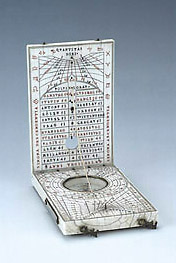
 |
| Catalogue |
 |
 Diptych Dial The inner part of the upper leaf has a pin gnomon dial indicating the length of the day (numbered in black from 8 to 16), planetary hours (numbered from VII to XII to V), and the declination of the sun, indicated by the symbols of the zodiacal signs on the borders. In the centre are holes for adjusting the latitude to 45?, 48?, 51?, 54?, indicated by 'POLVS GRAD'. Below, is a table of latitudes for 24 cities. On the sides the symbols of the zodiacal signs are indicated 'SINGNA [sic] ASCENDENTIA' and 'SINGNA [sic] DESCENDENTIA'. At the bottom is the signature 'HANNS TROSCHEL [star] [star]'. The inner part of the lower leaf has a compass with cardinal points engraved 'SEPT ENTRIO', 'ORI ENT', 'MERI DIES', 'OCCI DENT' as well as the declination ('26'). The string gnomon dial has hours numbered from 4 to 12 to 8 and IIII to XII to VIII with marks for the half and the quarter hours. The dial works for all the latitudes mentioned above, indicated by 'POLVS' but the hours are numbered only for 48? and 54?. Around it is the inscription 'HORAE AB MERIDIE [star]'. Below the compass is a pin gnomon dial for Italian hours numbered in brown from 10 to 23 and Babylonian hours numbered in red from 1 to 15. Below is the inscription 'SOLSTICIVM ESTIVVM [star]' and on the sides 'HORAE AB OCCASV [star] [star]' and 'HORAE AB ORTV [star] [star]'. There is simple decoration in the upper spandrels. The outer part of the lower leaf has a lunar volvelle and aspectarium, with table of Julian and Gregorian epacts starting for the year 1599 (or 1613). On the outer circle is inscribed 'DIES AETATIS LVNAE ET HORAE NOCTIS' ('day of the age of the moon and hour of the night'). On the bottom is punched the maker's mark (a star) and in the spandrel spaces are four bun feet. On the left edge is a compartment for the wind vane (missing). See P. Gouk, The Ivory Sundials of Nuremberg 1500-1700 (Cambridge, 1988). Ilaria Meliconi |



